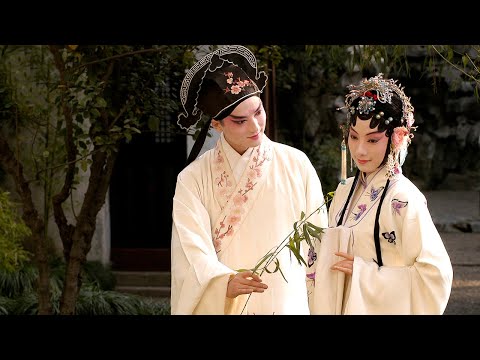BEIJING, April 12, 2024 /PRNewswire/ — A news report by China.org.cn on the Kunqu Opera “Peony Pavilion — Young Lovers’ Edition”:
“Love is of source unknown, yet it grows ever deeper. The living may die of it, by its power the dead live again.”
This verse, a Chinese-style footnote of love, derives from a Chinese drama “The Peony Pavilion,” written over 400 years ago by Ming Dynasty dramatist Tang Xianzu (1550-1616). This legendary love-themed play is a classic masterpiece of China’s traditional Kunqu Opera.
Recently, “The Peony Pavilion” hit the stage in Kaohsiung, Taipei, and Hsinchu City in Taiwan, created by artists from both the Chinese mainland and Taiwan, receiving a heartfelt welcome. For the audience in Taiwan, this show is a long-awaited reunion.
The story dates back to 2003.
That year, the Suzhou Kunqu Opera Theatre of Jiangsu Province and Pai Hsien-yung, a renowned Chinese American writer based in Taiwan, hit it off and decided to create a youth version of “The Peony Pavilion,” which would be presented by young performers. The aim was to drive the inheritance and revival of the art among young people on both sides of the Taiwan Strait.
“The Peony Pavilion” was originally a romantic tragicomedy about Du Liniang, who in her dream encountered and fell in love with young scholar Liu Mengmei, returned to life from the dead, and eventually married Liu to live happily ever after. In “Peony Pavilion — Young Lovers’ Edition,” Pai Hsien-yung kept the original lyrics, but adapted the play into three parts, namely “Love in a Dream,” “Love between a Mortal and a Ghost,” and “Love in This World.” The creation and rehearsals took a year, during which time Wang Shiyu and Zhang Jiqing, two Kunqu Opera masters from the Chinese mainland were invited to Suzhou to give personal tutoring to the two young lead performers of the play. Wu Su-chun, a famous choreographer from Taiwan choreographed three dance sections for “the goddess of flowers,” integrating dance elements into the performance of Kunqu Opera. Wang Toon, a famous director from Taiwan, who designed the costumes and acted as the artistic supervisor for the play, painted every curve of the patterns on the flower goddess’s costume.
This is a grand show that crystalized the efforts and strengths of opera culture and expertise on both sides of the Taiwan Strait. Hence, when the same troupe returned to the place of debut and staged the play to celebrate its 20th anniversary, this 9-hour-long romance classic once again became a blockbuster event, just like 20 years ago.
You can say it’s because the audience are touched by the exquisite performance of the Kunqu Opera, but it is also true that they are fascinated by the common traditional cultural elements across the Taiwan Strait.
The Chinese Kunqu Opera boasts a history of more than six centennials, passing on from ancient dynasties to modern times, and from the Chinese mainland to Taiwan. Records show that back during Qing Dynasty Emperor Qianlong’s reign (1736-1796), when Suzhou’s Liyuan Gongsuo, the Kunqu Opera practitioners’ association renovated their temple, they received a generous donation from Taiwan. Since the 1990s, Kunqu Opera artists from the Chinese mainland have performed in Taiwan on invitation, while engaging in video recording and teaching; the artists on both sides of the Taiwan Strait communicated rather frequently, and co-created many modern Kunqu Opera works. “Peony Pavilion — Young Lovers’ Edition” along with other classic works co-produced by them, bears witness to the history, heritage and deep bonds shared by people on both sides of the Taiwan Strait. The story of the play lasted 20 years, but its meaning extends far beyond the play itself or the mere two decades.
It’s a happy coincidence that just as we post this episode, members of a delegation of young people from Taiwan have just finished their root-seeking and cultural exchange tours in Guangdong, Shaanxi and Beijing. “The Peony Pavilion” is inherited and welcomed by young people from both the Chinese mainland and Taiwan, who are also an active force in cultural communications across the Taiwan Strait. Such links are no accident — the shared cultural roots and the mutual sense of belonging lie deep inside.
China Mosaic
http://chinamosaic.china.com.cn/index.htm
“The Peony Pavilion” performed again in Taiwan: Shared heritage across the Taiwan Strait
http://www.china.org.cn/video/2024-04/12/content_117120658.htm
SOURCE China.org.cn


